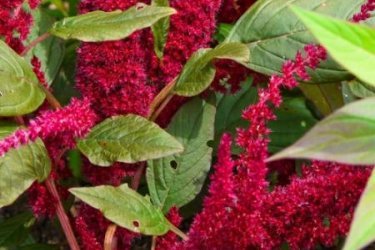Amaranth
Growing amaranth - the process is more than simple; you can get a good harvest even without much experience in crop production.
When and how to sow
Amaranth is the same cultivated amaranth; it can be planted with seeds or seedlings. Shchiritsa loves sunny areas and nutritious soils.
It will take about four months for agaric to ripen, regardless of whether it is a vegetable or an ornamental crop.
Sowing is carried out in May, when the soil is still quite moist, but already well warmed up. It is recommended to fertilize poor soils before sowing.
Sowing can be done manually; it is not recommended to sow too thickly; seedlings, as a rule, are friendly.
Densely located plants will shade each other, i.e. Some seedlings will need to be removed.
To obtain seedlings, seeds are sown in boxes in March. Maintain them at a temperature of + 20 C, periodically moistening the soil. Seedlings should not be overcooled. If necessary, seedlings are thinned out.
Picking is done when a pair of strong leaves appears and placed in separate cups.
You can plant them in the ground at the end of May. It is recommended to maintain a distance of 15 cm between seedlings.
Rules of care
Caring for ashiritsa is simple; we list the most important points:
- systematic watering, especially in the first weeks after planting; 2-3 month old bushes practically do not need watering;
- periodic feeding;
- soil fluffing, weeding;
- destruction of insect pests in case of their excessive reproduction, however, this rarely happens.
How is amaranth used?
Shchiritsa is an annual species; as an adult, it can survive when the temperature drops temporarily to 0 C.
After harvesting, at the end of the season, the remaining stems and leaves are disposed of. This is an excellent material for filling a compost pit.
The leaves, stems and seeds of the plant are used as food., preparations are made for the winter; for this, the treated parts of the plant are dried.
Recipes for dishes with amaranth are often found in books about healthy eating.
Shchiritsa is also a valuable forage crop; it is fed fresh to poultry and animals. Amaranth is dried for hay and used to make silage.
Amaranths tailed, two-colored, cherry velvet and others, which have no less attractive colors of leaves and inflorescences, are planted in gardens as ornamental crops.
If there is a large amount of land, they plan to grow amaranth as a business that brings relatively stable income.
The advantages of cultivated agarica are its resistance to the vagaries of weather, diseases and pest invasions.


